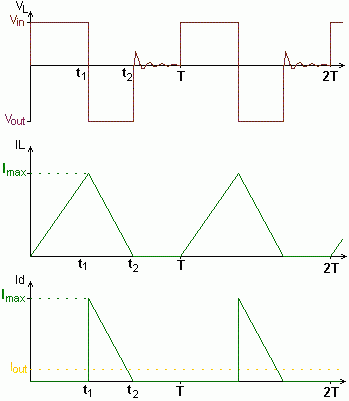
| Main page | | How to use the program | | Function principals | | Mathematics used in the program | | |
| Top of page | | Application | | Tips | | Literature Notes | | Help for choking coils |

|
| Illustration 1: Buck Boost Converter |
During the on-time of the transistor, there is an input voltage Vin applied across the inductor L. The inductor current IL increases linearly. Energy is loaded into the inductor.
During the blocking phase of the transistor, the current IL continues to flow through the inductor and loads the output capacitor Cout. The inductor transfers its energy to Cout.
One can make a distinction between continuous and discontinuous mode depending on whether the inductor current IL goes to zero or not.
For continuous mode using Faraday's Law gives:
![]()
From this it follows that:


| 
|
Continuous Mode | Discontinuous Mode |
Illustration 2: Operating modes of the Buck Boost Converter
Vin_min, Vin_max, Vout, Iout and f
Using these parameters, the program produces a proposal for L:




From this it follows that:
 ,
, ,
,
| Main page | | How to use the program | | Function principals | | Mathematics used in the program | | |
| Top of page | | Application | | Tips | | Literature Notes | | Help for choking coils |